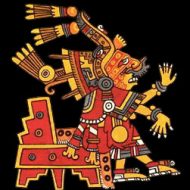Itztli : God of Obsidian
Listen
At a glance
| Description | |
|---|---|
| Origin | Aztec Mythology |
| Classification | Gods |
| Family Members | Tezcatlipoca (Father/Brother), Itzpapalotl, Yacatecuhtli (Siblings) |
| Region | Mexico |
| Associated With | Obsidian, Stone, Carving |
Itztli
Introduction
The very name Itztli, signifying “obsidian,” carries echoes of sharp edges and ultimate finality. This deity stands as the divine embodiment of the volcanic glass highly esteemed by the Aztecs—a material employed in crafting tools, weapons, and the sacrificial knives that spilled blood to nourish the cosmos. Itztli, intricately linked with the obsidian blade, rises from the depths of Aztec mythology as a profoundly significant deity. It emerges as a formidable and enigmatic figure, embodying the intricate dualities of life and death, creation and destruction.
Physical Traits
Itztli holds sway over various domains, assuming the roles of the god of night, sacrifice, and war. One of Itztli’s paramount responsibilities is his guardianship of the sacred cuchillas, the obsidian blades utilized in ritual sacrifices. These intricately adorned blades bear endearing faces with large, piercing eyes, accentuating their divine significance. Depictions of Itztli exhibit variability, often capturing the deity’s dual nature. In some representations, he appears as a fierce warrior bedecked with obsidian blades and jaguar pelts, his visage painted black akin to the volcanic glass he embodies. Alternately, other depictions portray him as a skeletal figure, stark white against the darkness, symbolizing death and sacrifice. Yet another interpretation presents Itztli as a two-headed serpent—one head human, the other obsidian—symbolizing the duality inherent in life and death, creation and destruction.
The obsidian blade, a central motif in portrayals of Itztli, symbolizes the deity’s dual nature. On one edge, it holds the potential for creation, as obsidian was instrumental in crafting intricate tools and ornaments. On the other edge, the blade signifies the inevitability of death, underscoring Itztli’s role as a deity presiding over the underworld.
Family
Itztli did not exist in isolation but was part of the Tezcatlipoca complex, a group of deities associated with sorcery, night, and the obsidian mirror reflecting the darkness within. Tezcatlipoca, also known as the Smoking Mirror, was considered either Itztli’s father or brother, depending on the interpretation. The complex also included other members like Itzpapalotl, the Obsidian Butterfly Goddess, and Yacatecuhtli, the Wind God, reinforcing Itztli’s connection to both earthly and celestial realms. Additionally, Itztli shares similarities with Itztlacoliuhqui-Ixquimilli and is connected to Tezcatlipoca. His association with the gods of the hunt intertwines him with the primal forces of nature, underscoring his dominion over all aspects of life and death.
Other names
Itztli wasn’t limited to a solitary name; alternative titles added layers to his identity. Referred to as Tezcapoctli, meaning “Left-Handed Smoking Mirror,” this name underscored his connection to Tezcatlipoca and the ominous left side. Another appellation, Ixquimilli, tied him to the goddess of fire and childbirth, accentuating the life-giving aspect of sacrifice. These various aliases weave a multifaceted portrait of Itztli, a deity capable of embodying both the role of the harbinger of death and that of renewal.
Powers and Abilities
As the second Lord of the Night, Itztli commands formidable authority over these realms, directing the use of sacred obsidian blades in ritual sacrifices. His presence is entwined with both darkness and conflict, serving as a manifestation of the intricate duality inherent in life and death. Itztli’s association with the night symbolizes the unseen mysteries that unfold under the shroud of darkness. As the embodiment of obsidian, he wields immense power, demonstrating his ability to shape-shift into the forms of creatures like jaguars and owls, beings associated with the night and the hunt.
Proficient with the obsidian blade, Itztli can inflict wounds that transcend the physical, reaching into the realm of the spiritual. His gaze, mirroring the depths of the obsidian mirror, possesses the capacity to penetrate illusions and expose concealed truths. Additionally, Itztli holds dominion over the night, a period when the veil between worlds becomes thin, enabling him to influence the dreams and fears of mortals.
Modern Day Influence
Present-day Mexican artists embark on a reinterpretation of Itztli through murals and sculptures, while others delve into his symbolism within literature and performance art. The deity’s presence is not confined to traditional mediums; even video games like “Age of Empires” spotlight Itztli, presenting his formidable power and captivating backstory to a global audience. In the artistic domain, Itztli’s symbolic ties to the jaguar and the obsidian blade frequently manifest in contemporary creations. Paintings, sculptures, and digital art serve as tributes to the deity’s enigmatic essence, offering diverse interpretations of its role in the cosmic equilibrium and the intricate interplay between creation and destruction.
Related Images
Frequently Asked Questions
What is lorem Ipsum?
I am text block. Click edit button to change this text. Lorem ipsum dolor sit amet, consectetur adipiscing elit. Ut elit tellus, luctus nec ullamcorper mattis, pulvinar dapibus leo.
What is lorem Ipsum?
I am text block. Click edit button to change this text. Lorem ipsum dolor sit amet, consectetur adipiscing elit. Ut elit tellus, luctus nec ullamcorper mattis, pulvinar dapibus leo.
What is lorem Ipsum?
I am text block. Click edit button to change this text. Lorem ipsum dolor sit amet, consectetur adipiscing elit. Ut elit tellus, luctus nec ullamcorper mattis, pulvinar dapibus leo.
What is lorem Ipsum?
I am text block. Click edit button to change this text. Lorem ipsum dolor sit amet, consectetur adipiscing elit. Ut elit tellus, luctus nec ullamcorper mattis, pulvinar dapibus leo.
What is lorem Ipsum?
I am text block. Click edit button to change this text. Lorem ipsum dolor sit amet, consectetur adipiscing elit. Ut elit tellus, luctus nec ullamcorper mattis, pulvinar dapibus leo.











